Large Assets Project: Tender Request, Financing and Conditions
VerifiedAdded on 2023/06/11
|13
|2971
|174
Report
AI Summary
This document presents a tender request for a large assets project, defining a project in the context of large assets and explaining project justification through environment analysis, solution proposals, and financial assessments. It outlines a nine-step project justification process and a five-step contract process, detailing financing methods involving equity investors and cash flow projections. The report identifies critical project conditions such as governance, objectives, commitment, and secured funding, alongside essential project team members and key project processes from conception to closure. Furthermore, it provides expected estimations for project labor, plant, materials, and subcontractors, while also specifying requirements for project change management, quality assurance, document management, dispute resolution, and safety protocols, ensuring a comprehensive approach to project execution and risk mitigation.
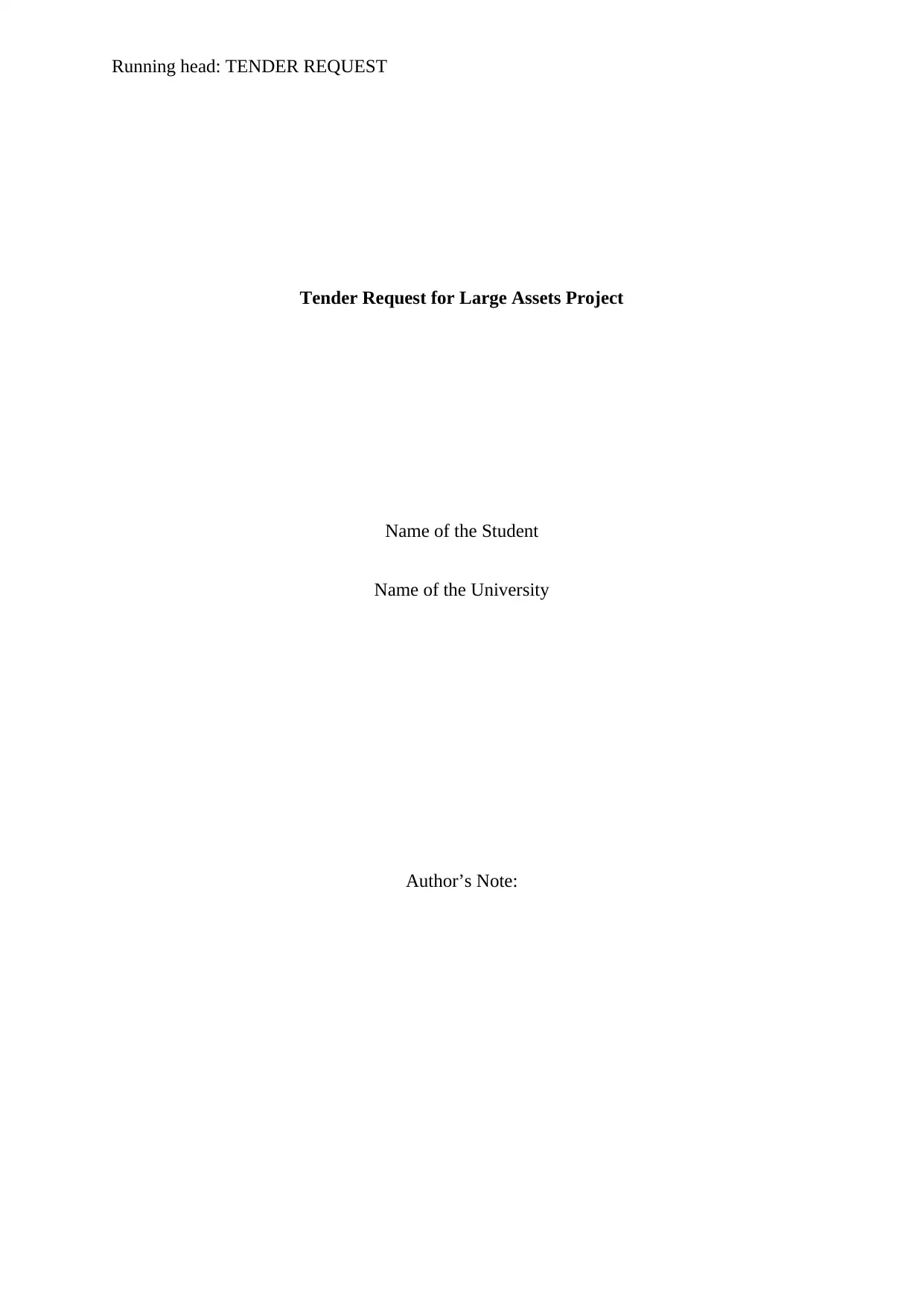
Running head: TENDER REQUEST
Tender Request for Large Assets Project
Name of the Student
Name of the University
Author’s Note:
Tender Request for Large Assets Project
Name of the Student
Name of the University
Author’s Note:
Paraphrase This Document
Need a fresh take? Get an instant paraphrase of this document with our AI Paraphraser
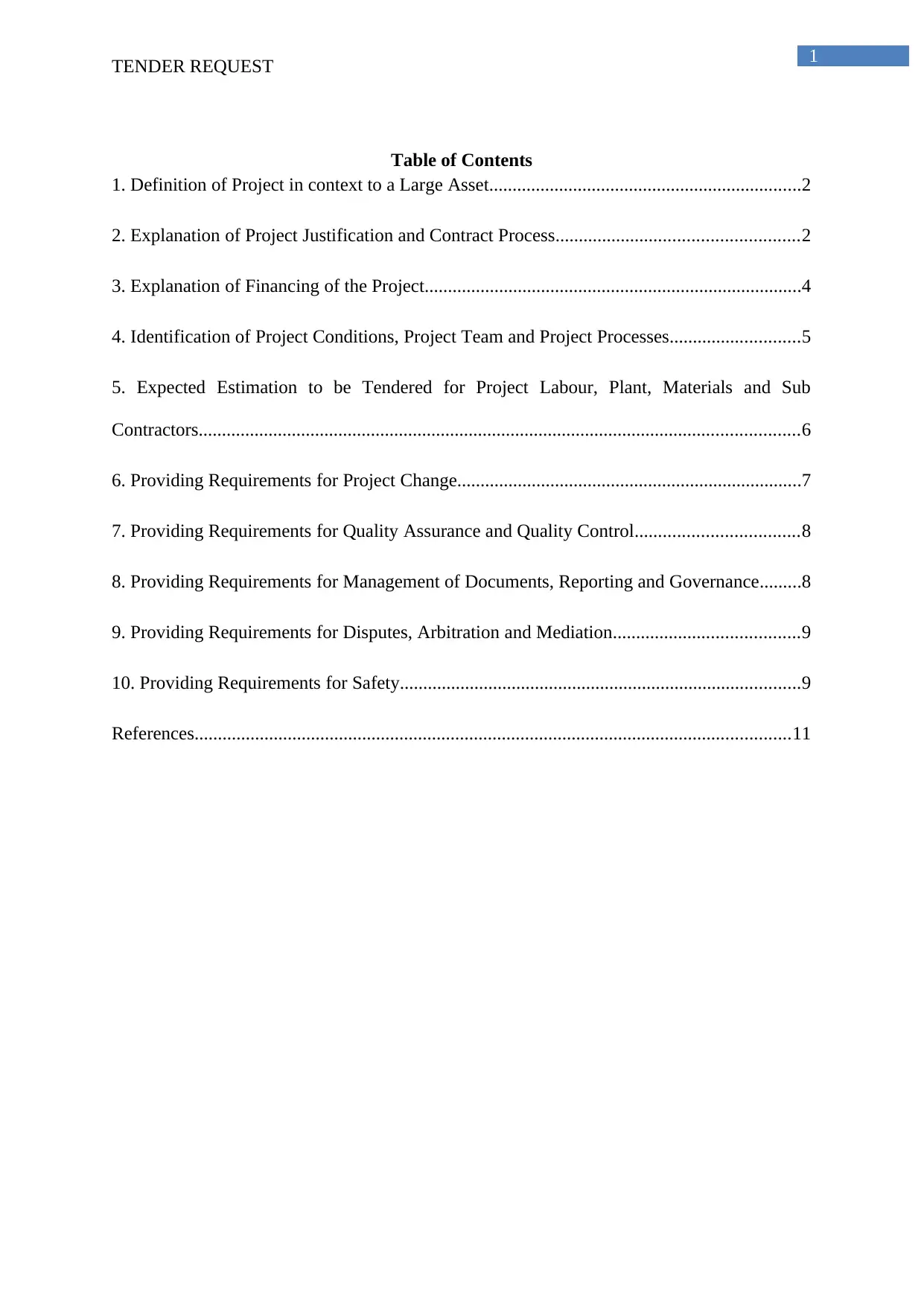
1
TENDER REQUEST
Table of Contents
1. Definition of Project in context to a Large Asset...................................................................2
2. Explanation of Project Justification and Contract Process....................................................2
3. Explanation of Financing of the Project.................................................................................4
4. Identification of Project Conditions, Project Team and Project Processes............................5
5. Expected Estimation to be Tendered for Project Labour, Plant, Materials and Sub
Contractors.................................................................................................................................6
6. Providing Requirements for Project Change..........................................................................7
7. Providing Requirements for Quality Assurance and Quality Control...................................8
8. Providing Requirements for Management of Documents, Reporting and Governance.........8
9. Providing Requirements for Disputes, Arbitration and Mediation........................................9
10. Providing Requirements for Safety......................................................................................9
References................................................................................................................................11
TENDER REQUEST
Table of Contents
1. Definition of Project in context to a Large Asset...................................................................2
2. Explanation of Project Justification and Contract Process....................................................2
3. Explanation of Financing of the Project.................................................................................4
4. Identification of Project Conditions, Project Team and Project Processes............................5
5. Expected Estimation to be Tendered for Project Labour, Plant, Materials and Sub
Contractors.................................................................................................................................6
6. Providing Requirements for Project Change..........................................................................7
7. Providing Requirements for Quality Assurance and Quality Control...................................8
8. Providing Requirements for Management of Documents, Reporting and Governance.........8
9. Providing Requirements for Disputes, Arbitration and Mediation........................................9
10. Providing Requirements for Safety......................................................................................9
References................................................................................................................................11
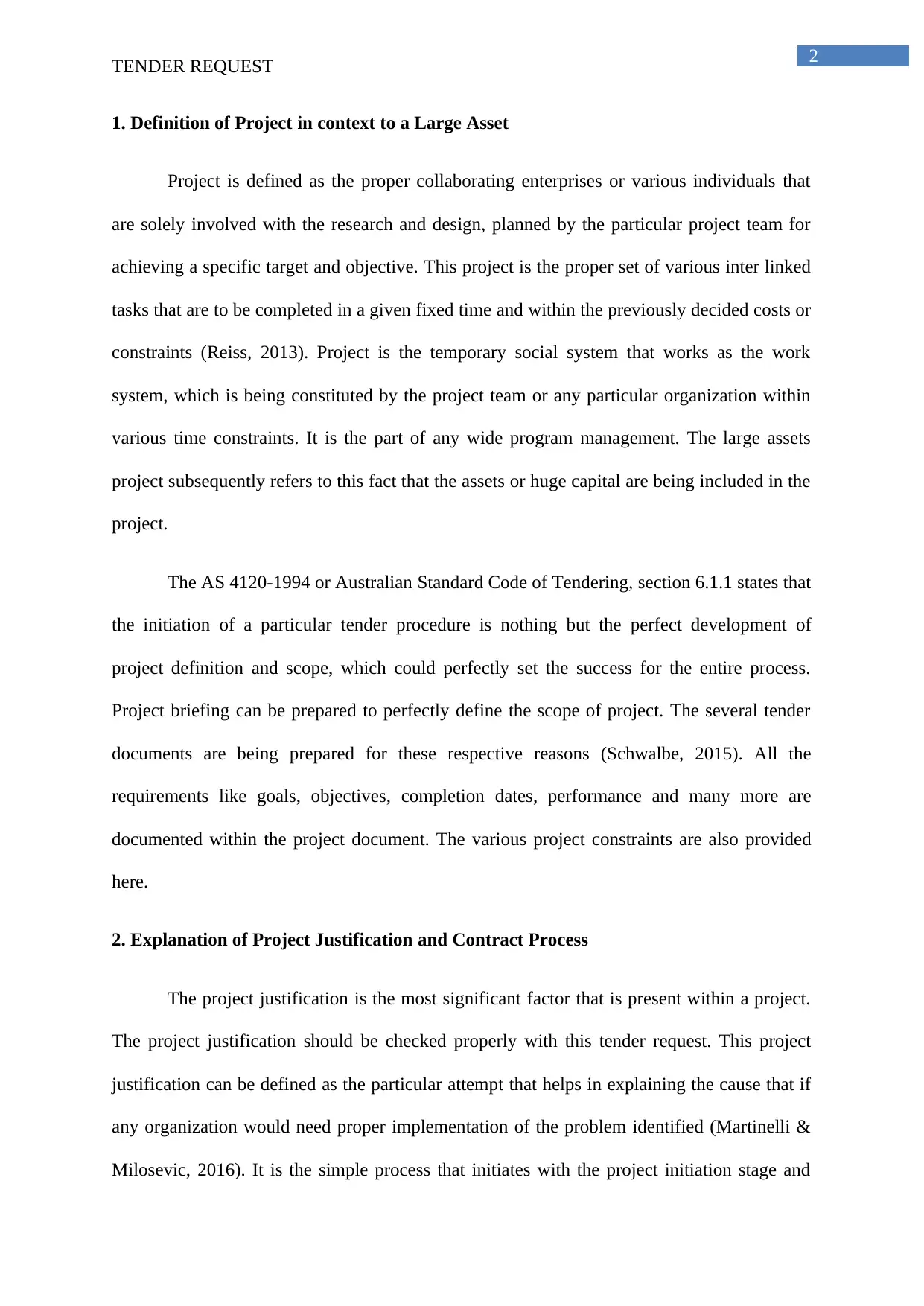
2
TENDER REQUEST
1. Definition of Project in context to a Large Asset
Project is defined as the proper collaborating enterprises or various individuals that
are solely involved with the research and design, planned by the particular project team for
achieving a specific target and objective. This project is the proper set of various inter linked
tasks that are to be completed in a given fixed time and within the previously decided costs or
constraints (Reiss, 2013). Project is the temporary social system that works as the work
system, which is being constituted by the project team or any particular organization within
various time constraints. It is the part of any wide program management. The large assets
project subsequently refers to this fact that the assets or huge capital are being included in the
project.
The AS 4120-1994 or Australian Standard Code of Tendering, section 6.1.1 states that
the initiation of a particular tender procedure is nothing but the perfect development of
project definition and scope, which could perfectly set the success for the entire process.
Project briefing can be prepared to perfectly define the scope of project. The several tender
documents are being prepared for these respective reasons (Schwalbe, 2015). All the
requirements like goals, objectives, completion dates, performance and many more are
documented within the project document. The various project constraints are also provided
here.
2. Explanation of Project Justification and Contract Process
The project justification is the most significant factor that is present within a project.
The project justification should be checked properly with this tender request. This project
justification can be defined as the particular attempt that helps in explaining the cause that if
any organization would need proper implementation of the problem identified (Martinelli &
Milosevic, 2016). It is the simple process that initiates with the project initiation stage and
TENDER REQUEST
1. Definition of Project in context to a Large Asset
Project is defined as the proper collaborating enterprises or various individuals that
are solely involved with the research and design, planned by the particular project team for
achieving a specific target and objective. This project is the proper set of various inter linked
tasks that are to be completed in a given fixed time and within the previously decided costs or
constraints (Reiss, 2013). Project is the temporary social system that works as the work
system, which is being constituted by the project team or any particular organization within
various time constraints. It is the part of any wide program management. The large assets
project subsequently refers to this fact that the assets or huge capital are being included in the
project.
The AS 4120-1994 or Australian Standard Code of Tendering, section 6.1.1 states that
the initiation of a particular tender procedure is nothing but the perfect development of
project definition and scope, which could perfectly set the success for the entire process.
Project briefing can be prepared to perfectly define the scope of project. The several tender
documents are being prepared for these respective reasons (Schwalbe, 2015). All the
requirements like goals, objectives, completion dates, performance and many more are
documented within the project document. The various project constraints are also provided
here.
2. Explanation of Project Justification and Contract Process
The project justification is the most significant factor that is present within a project.
The project justification should be checked properly with this tender request. This project
justification can be defined as the particular attempt that helps in explaining the cause that if
any organization would need proper implementation of the problem identified (Martinelli &
Milosevic, 2016). It is the simple process that initiates with the project initiation stage and
⊘ This is a preview!⊘
Do you want full access?
Subscribe today to unlock all pages.

Trusted by 1+ million students worldwide
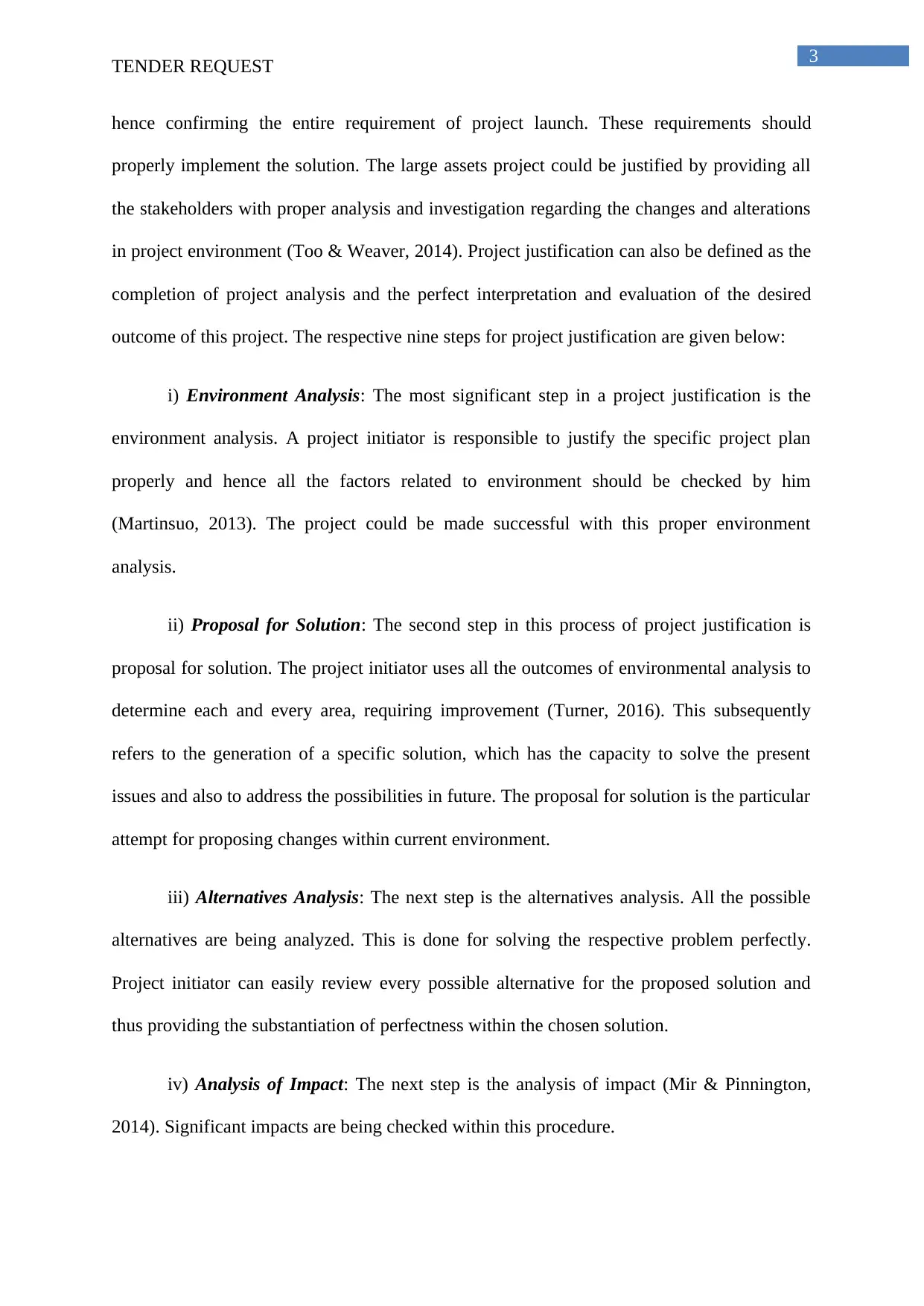
3
TENDER REQUEST
hence confirming the entire requirement of project launch. These requirements should
properly implement the solution. The large assets project could be justified by providing all
the stakeholders with proper analysis and investigation regarding the changes and alterations
in project environment (Too & Weaver, 2014). Project justification can also be defined as the
completion of project analysis and the perfect interpretation and evaluation of the desired
outcome of this project. The respective nine steps for project justification are given below:
i) Environment Analysis: The most significant step in a project justification is the
environment analysis. A project initiator is responsible to justify the specific project plan
properly and hence all the factors related to environment should be checked by him
(Martinsuo, 2013). The project could be made successful with this proper environment
analysis.
ii) Proposal for Solution: The second step in this process of project justification is
proposal for solution. The project initiator uses all the outcomes of environmental analysis to
determine each and every area, requiring improvement (Turner, 2016). This subsequently
refers to the generation of a specific solution, which has the capacity to solve the present
issues and also to address the possibilities in future. The proposal for solution is the particular
attempt for proposing changes within current environment.
iii) Alternatives Analysis: The next step is the alternatives analysis. All the possible
alternatives are being analyzed. This is done for solving the respective problem perfectly.
Project initiator can easily review every possible alternative for the proposed solution and
thus providing the substantiation of perfectness within the chosen solution.
iv) Analysis of Impact: The next step is the analysis of impact (Mir & Pinnington,
2014). Significant impacts are being checked within this procedure.
TENDER REQUEST
hence confirming the entire requirement of project launch. These requirements should
properly implement the solution. The large assets project could be justified by providing all
the stakeholders with proper analysis and investigation regarding the changes and alterations
in project environment (Too & Weaver, 2014). Project justification can also be defined as the
completion of project analysis and the perfect interpretation and evaluation of the desired
outcome of this project. The respective nine steps for project justification are given below:
i) Environment Analysis: The most significant step in a project justification is the
environment analysis. A project initiator is responsible to justify the specific project plan
properly and hence all the factors related to environment should be checked by him
(Martinsuo, 2013). The project could be made successful with this proper environment
analysis.
ii) Proposal for Solution: The second step in this process of project justification is
proposal for solution. The project initiator uses all the outcomes of environmental analysis to
determine each and every area, requiring improvement (Turner, 2016). This subsequently
refers to the generation of a specific solution, which has the capacity to solve the present
issues and also to address the possibilities in future. The proposal for solution is the particular
attempt for proposing changes within current environment.
iii) Alternatives Analysis: The next step is the alternatives analysis. All the possible
alternatives are being analyzed. This is done for solving the respective problem perfectly.
Project initiator can easily review every possible alternative for the proposed solution and
thus providing the substantiation of perfectness within the chosen solution.
iv) Analysis of Impact: The next step is the analysis of impact (Mir & Pinnington,
2014). Significant impacts are being checked within this procedure.
Paraphrase This Document
Need a fresh take? Get an instant paraphrase of this document with our AI Paraphraser
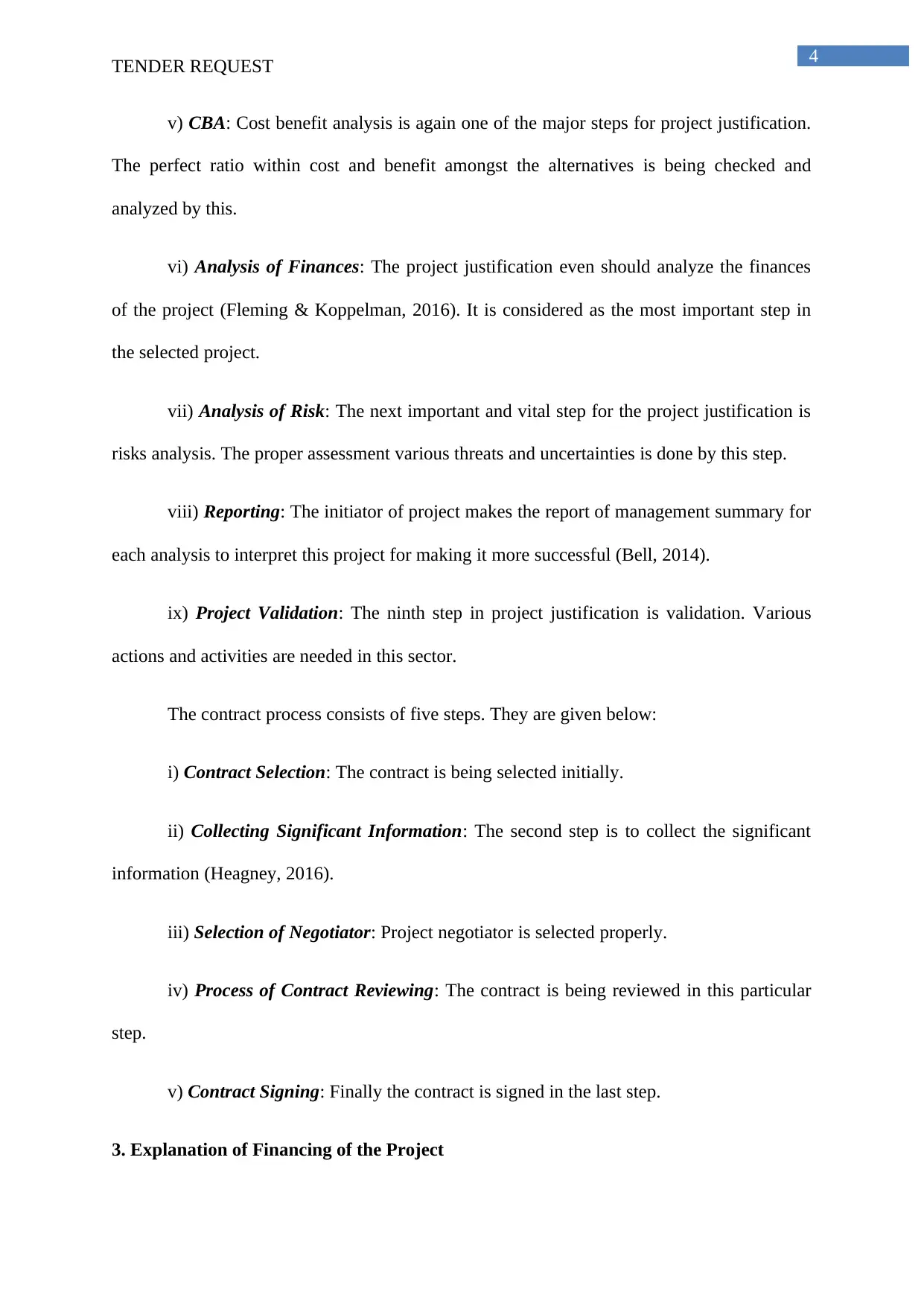
4
TENDER REQUEST
v) CBA: Cost benefit analysis is again one of the major steps for project justification.
The perfect ratio within cost and benefit amongst the alternatives is being checked and
analyzed by this.
vi) Analysis of Finances: The project justification even should analyze the finances
of the project (Fleming & Koppelman, 2016). It is considered as the most important step in
the selected project.
vii) Analysis of Risk: The next important and vital step for the project justification is
risks analysis. The proper assessment various threats and uncertainties is done by this step.
viii) Reporting: The initiator of project makes the report of management summary for
each analysis to interpret this project for making it more successful (Bell, 2014).
ix) Project Validation: The ninth step in project justification is validation. Various
actions and activities are needed in this sector.
The contract process consists of five steps. They are given below:
i) Contract Selection: The contract is being selected initially.
ii) Collecting Significant Information: The second step is to collect the significant
information (Heagney, 2016).
iii) Selection of Negotiator: Project negotiator is selected properly.
iv) Process of Contract Reviewing: The contract is being reviewed in this particular
step.
v) Contract Signing: Finally the contract is signed in the last step.
3. Explanation of Financing of the Project
TENDER REQUEST
v) CBA: Cost benefit analysis is again one of the major steps for project justification.
The perfect ratio within cost and benefit amongst the alternatives is being checked and
analyzed by this.
vi) Analysis of Finances: The project justification even should analyze the finances
of the project (Fleming & Koppelman, 2016). It is considered as the most important step in
the selected project.
vii) Analysis of Risk: The next important and vital step for the project justification is
risks analysis. The proper assessment various threats and uncertainties is done by this step.
viii) Reporting: The initiator of project makes the report of management summary for
each analysis to interpret this project for making it more successful (Bell, 2014).
ix) Project Validation: The ninth step in project justification is validation. Various
actions and activities are needed in this sector.
The contract process consists of five steps. They are given below:
i) Contract Selection: The contract is being selected initially.
ii) Collecting Significant Information: The second step is to collect the significant
information (Heagney, 2016).
iii) Selection of Negotiator: Project negotiator is selected properly.
iv) Process of Contract Reviewing: The contract is being reviewed in this particular
step.
v) Contract Signing: Finally the contract is signed in the last step.
3. Explanation of Financing of the Project
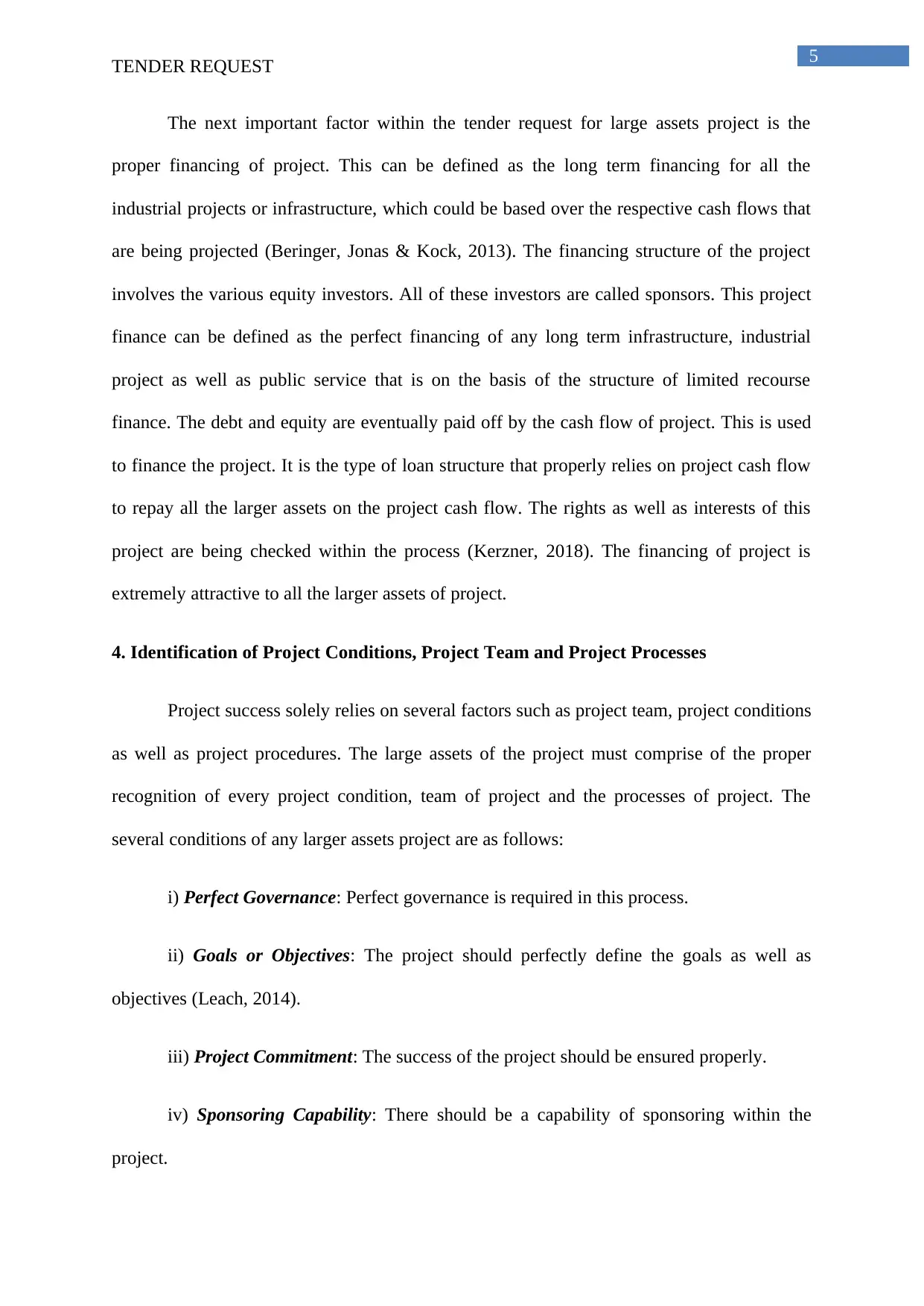
5
TENDER REQUEST
The next important factor within the tender request for large assets project is the
proper financing of project. This can be defined as the long term financing for all the
industrial projects or infrastructure, which could be based over the respective cash flows that
are being projected (Beringer, Jonas & Kock, 2013). The financing structure of the project
involves the various equity investors. All of these investors are called sponsors. This project
finance can be defined as the perfect financing of any long term infrastructure, industrial
project as well as public service that is on the basis of the structure of limited recourse
finance. The debt and equity are eventually paid off by the cash flow of project. This is used
to finance the project. It is the type of loan structure that properly relies on project cash flow
to repay all the larger assets on the project cash flow. The rights as well as interests of this
project are being checked within the process (Kerzner, 2018). The financing of project is
extremely attractive to all the larger assets of project.
4. Identification of Project Conditions, Project Team and Project Processes
Project success solely relies on several factors such as project team, project conditions
as well as project procedures. The large assets of the project must comprise of the proper
recognition of every project condition, team of project and the processes of project. The
several conditions of any larger assets project are as follows:
i) Perfect Governance: Perfect governance is required in this process.
ii) Goals or Objectives: The project should perfectly define the goals as well as
objectives (Leach, 2014).
iii) Project Commitment: The success of the project should be ensured properly.
iv) Sponsoring Capability: There should be a capability of sponsoring within the
project.
TENDER REQUEST
The next important factor within the tender request for large assets project is the
proper financing of project. This can be defined as the long term financing for all the
industrial projects or infrastructure, which could be based over the respective cash flows that
are being projected (Beringer, Jonas & Kock, 2013). The financing structure of the project
involves the various equity investors. All of these investors are called sponsors. This project
finance can be defined as the perfect financing of any long term infrastructure, industrial
project as well as public service that is on the basis of the structure of limited recourse
finance. The debt and equity are eventually paid off by the cash flow of project. This is used
to finance the project. It is the type of loan structure that properly relies on project cash flow
to repay all the larger assets on the project cash flow. The rights as well as interests of this
project are being checked within the process (Kerzner, 2018). The financing of project is
extremely attractive to all the larger assets of project.
4. Identification of Project Conditions, Project Team and Project Processes
Project success solely relies on several factors such as project team, project conditions
as well as project procedures. The large assets of the project must comprise of the proper
recognition of every project condition, team of project and the processes of project. The
several conditions of any larger assets project are as follows:
i) Perfect Governance: Perfect governance is required in this process.
ii) Goals or Objectives: The project should perfectly define the goals as well as
objectives (Leach, 2014).
iii) Project Commitment: The success of the project should be ensured properly.
iv) Sponsoring Capability: There should be a capability of sponsoring within the
project.
⊘ This is a preview!⊘
Do you want full access?
Subscribe today to unlock all pages.

Trusted by 1+ million students worldwide
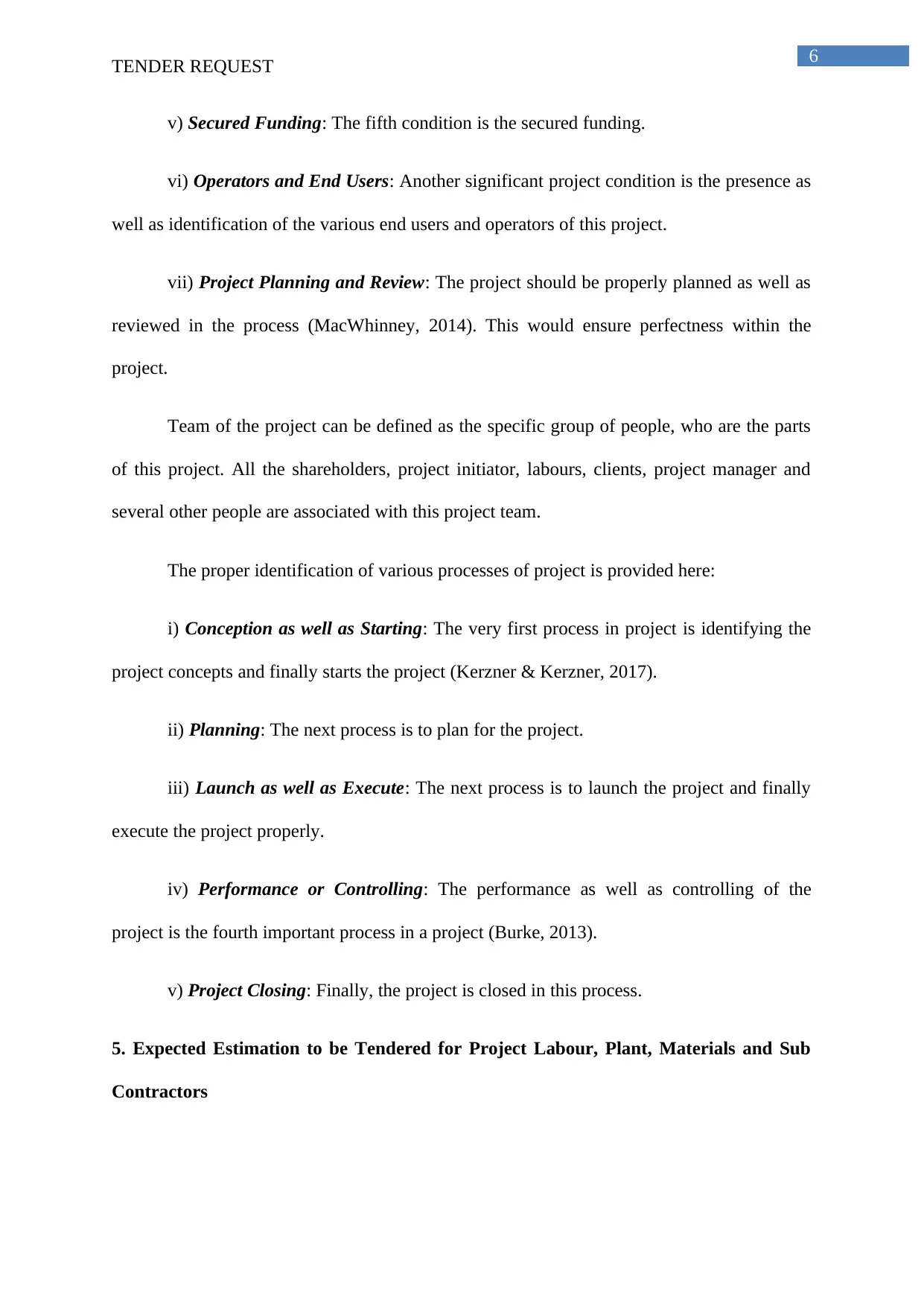
6
TENDER REQUEST
v) Secured Funding: The fifth condition is the secured funding.
vi) Operators and End Users: Another significant project condition is the presence as
well as identification of the various end users and operators of this project.
vii) Project Planning and Review: The project should be properly planned as well as
reviewed in the process (MacWhinney, 2014). This would ensure perfectness within the
project.
Team of the project can be defined as the specific group of people, who are the parts
of this project. All the shareholders, project initiator, labours, clients, project manager and
several other people are associated with this project team.
The proper identification of various processes of project is provided here:
i) Conception as well as Starting: The very first process in project is identifying the
project concepts and finally starts the project (Kerzner & Kerzner, 2017).
ii) Planning: The next process is to plan for the project.
iii) Launch as well as Execute: The next process is to launch the project and finally
execute the project properly.
iv) Performance or Controlling: The performance as well as controlling of the
project is the fourth important process in a project (Burke, 2013).
v) Project Closing: Finally, the project is closed in this process.
5. Expected Estimation to be Tendered for Project Labour, Plant, Materials and Sub
Contractors
TENDER REQUEST
v) Secured Funding: The fifth condition is the secured funding.
vi) Operators and End Users: Another significant project condition is the presence as
well as identification of the various end users and operators of this project.
vii) Project Planning and Review: The project should be properly planned as well as
reviewed in the process (MacWhinney, 2014). This would ensure perfectness within the
project.
Team of the project can be defined as the specific group of people, who are the parts
of this project. All the shareholders, project initiator, labours, clients, project manager and
several other people are associated with this project team.
The proper identification of various processes of project is provided here:
i) Conception as well as Starting: The very first process in project is identifying the
project concepts and finally starts the project (Kerzner & Kerzner, 2017).
ii) Planning: The next process is to plan for the project.
iii) Launch as well as Execute: The next process is to launch the project and finally
execute the project properly.
iv) Performance or Controlling: The performance as well as controlling of the
project is the fourth important process in a project (Burke, 2013).
v) Project Closing: Finally, the project is closed in this process.
5. Expected Estimation to be Tendered for Project Labour, Plant, Materials and Sub
Contractors
Paraphrase This Document
Need a fresh take? Get an instant paraphrase of this document with our AI Paraphraser
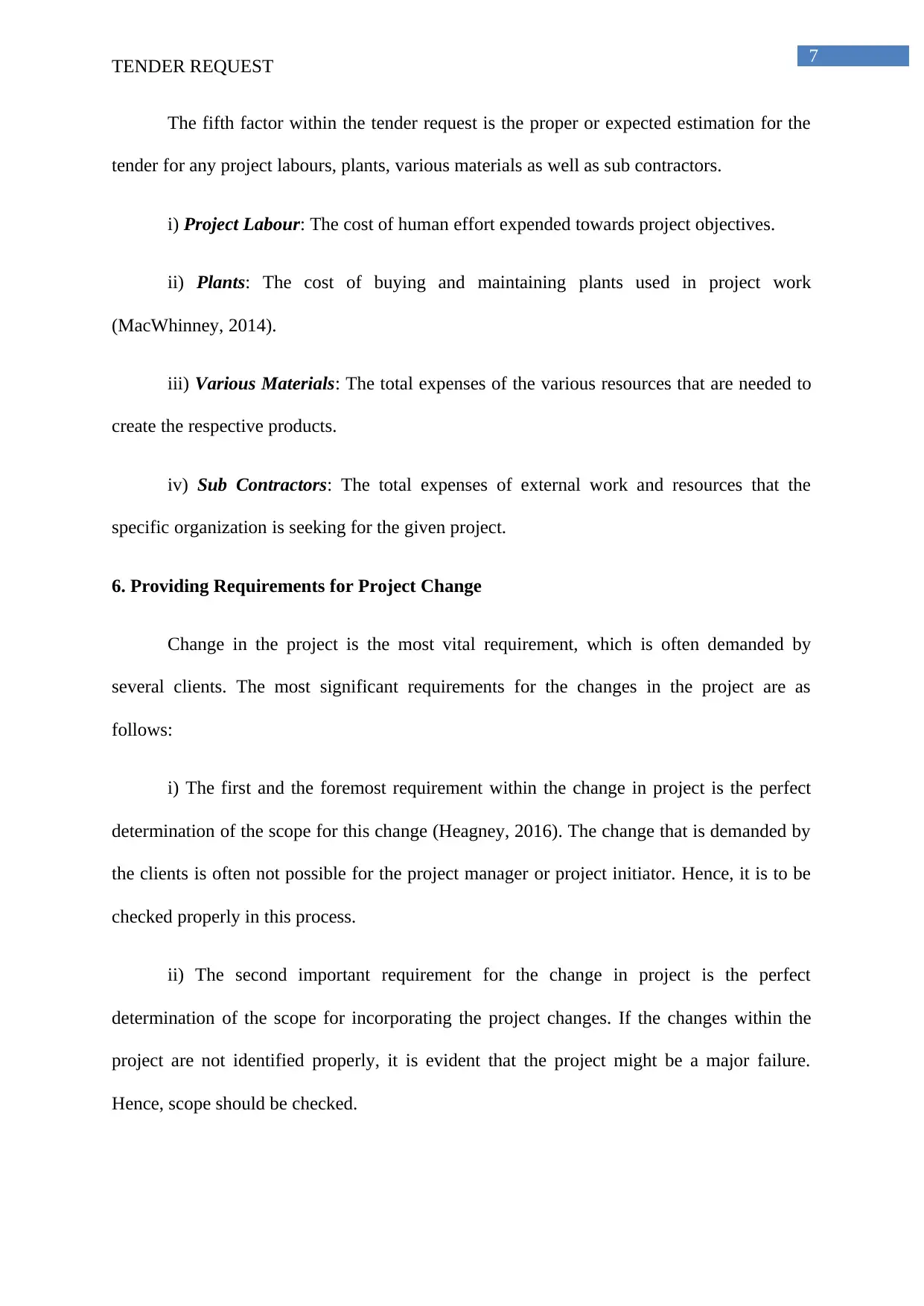
7
TENDER REQUEST
The fifth factor within the tender request is the proper or expected estimation for the
tender for any project labours, plants, various materials as well as sub contractors.
i) Project Labour: The cost of human effort expended towards project objectives.
ii) Plants: The cost of buying and maintaining plants used in project work
(MacWhinney, 2014).
iii) Various Materials: The total expenses of the various resources that are needed to
create the respective products.
iv) Sub Contractors: The total expenses of external work and resources that the
specific organization is seeking for the given project.
6. Providing Requirements for Project Change
Change in the project is the most vital requirement, which is often demanded by
several clients. The most significant requirements for the changes in the project are as
follows:
i) The first and the foremost requirement within the change in project is the perfect
determination of the scope for this change (Heagney, 2016). The change that is demanded by
the clients is often not possible for the project manager or project initiator. Hence, it is to be
checked properly in this process.
ii) The second important requirement for the change in project is the perfect
determination of the scope for incorporating the project changes. If the changes within the
project are not identified properly, it is evident that the project might be a major failure.
Hence, scope should be checked.
TENDER REQUEST
The fifth factor within the tender request is the proper or expected estimation for the
tender for any project labours, plants, various materials as well as sub contractors.
i) Project Labour: The cost of human effort expended towards project objectives.
ii) Plants: The cost of buying and maintaining plants used in project work
(MacWhinney, 2014).
iii) Various Materials: The total expenses of the various resources that are needed to
create the respective products.
iv) Sub Contractors: The total expenses of external work and resources that the
specific organization is seeking for the given project.
6. Providing Requirements for Project Change
Change in the project is the most vital requirement, which is often demanded by
several clients. The most significant requirements for the changes in the project are as
follows:
i) The first and the foremost requirement within the change in project is the perfect
determination of the scope for this change (Heagney, 2016). The change that is demanded by
the clients is often not possible for the project manager or project initiator. Hence, it is to be
checked properly in this process.
ii) The second important requirement for the change in project is the perfect
determination of the scope for incorporating the project changes. If the changes within the
project are not identified properly, it is evident that the project might be a major failure.
Hence, scope should be checked.
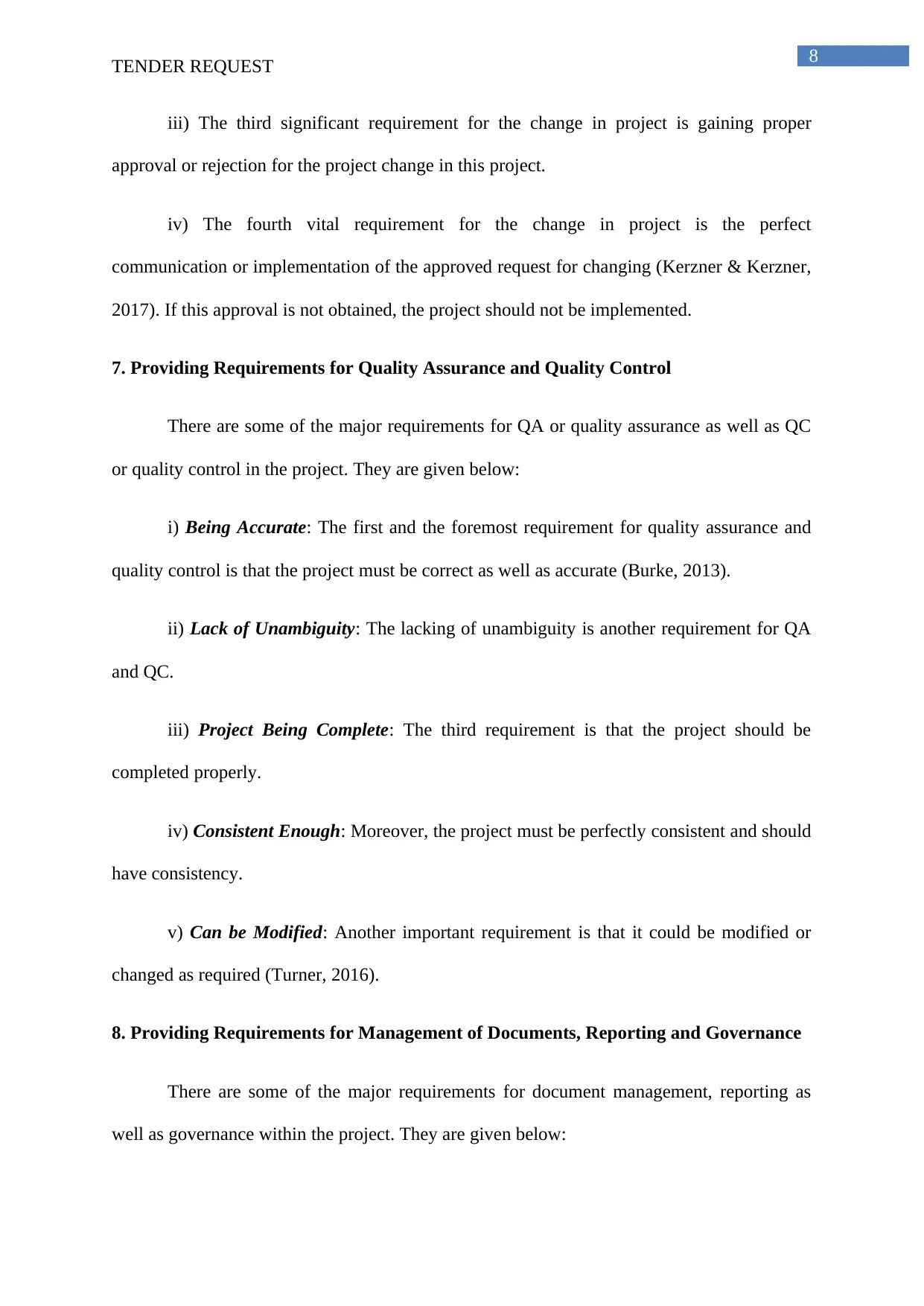
8
TENDER REQUEST
iii) The third significant requirement for the change in project is gaining proper
approval or rejection for the project change in this project.
iv) The fourth vital requirement for the change in project is the perfect
communication or implementation of the approved request for changing (Kerzner & Kerzner,
2017). If this approval is not obtained, the project should not be implemented.
7. Providing Requirements for Quality Assurance and Quality Control
There are some of the major requirements for QA or quality assurance as well as QC
or quality control in the project. They are given below:
i) Being Accurate: The first and the foremost requirement for quality assurance and
quality control is that the project must be correct as well as accurate (Burke, 2013).
ii) Lack of Unambiguity: The lacking of unambiguity is another requirement for QA
and QC.
iii) Project Being Complete: The third requirement is that the project should be
completed properly.
iv) Consistent Enough: Moreover, the project must be perfectly consistent and should
have consistency.
v) Can be Modified: Another important requirement is that it could be modified or
changed as required (Turner, 2016).
8. Providing Requirements for Management of Documents, Reporting and Governance
There are some of the major requirements for document management, reporting as
well as governance within the project. They are given below:
TENDER REQUEST
iii) The third significant requirement for the change in project is gaining proper
approval or rejection for the project change in this project.
iv) The fourth vital requirement for the change in project is the perfect
communication or implementation of the approved request for changing (Kerzner & Kerzner,
2017). If this approval is not obtained, the project should not be implemented.
7. Providing Requirements for Quality Assurance and Quality Control
There are some of the major requirements for QA or quality assurance as well as QC
or quality control in the project. They are given below:
i) Being Accurate: The first and the foremost requirement for quality assurance and
quality control is that the project must be correct as well as accurate (Burke, 2013).
ii) Lack of Unambiguity: The lacking of unambiguity is another requirement for QA
and QC.
iii) Project Being Complete: The third requirement is that the project should be
completed properly.
iv) Consistent Enough: Moreover, the project must be perfectly consistent and should
have consistency.
v) Can be Modified: Another important requirement is that it could be modified or
changed as required (Turner, 2016).
8. Providing Requirements for Management of Documents, Reporting and Governance
There are some of the major requirements for document management, reporting as
well as governance within the project. They are given below:
⊘ This is a preview!⊘
Do you want full access?
Subscribe today to unlock all pages.

Trusted by 1+ million students worldwide
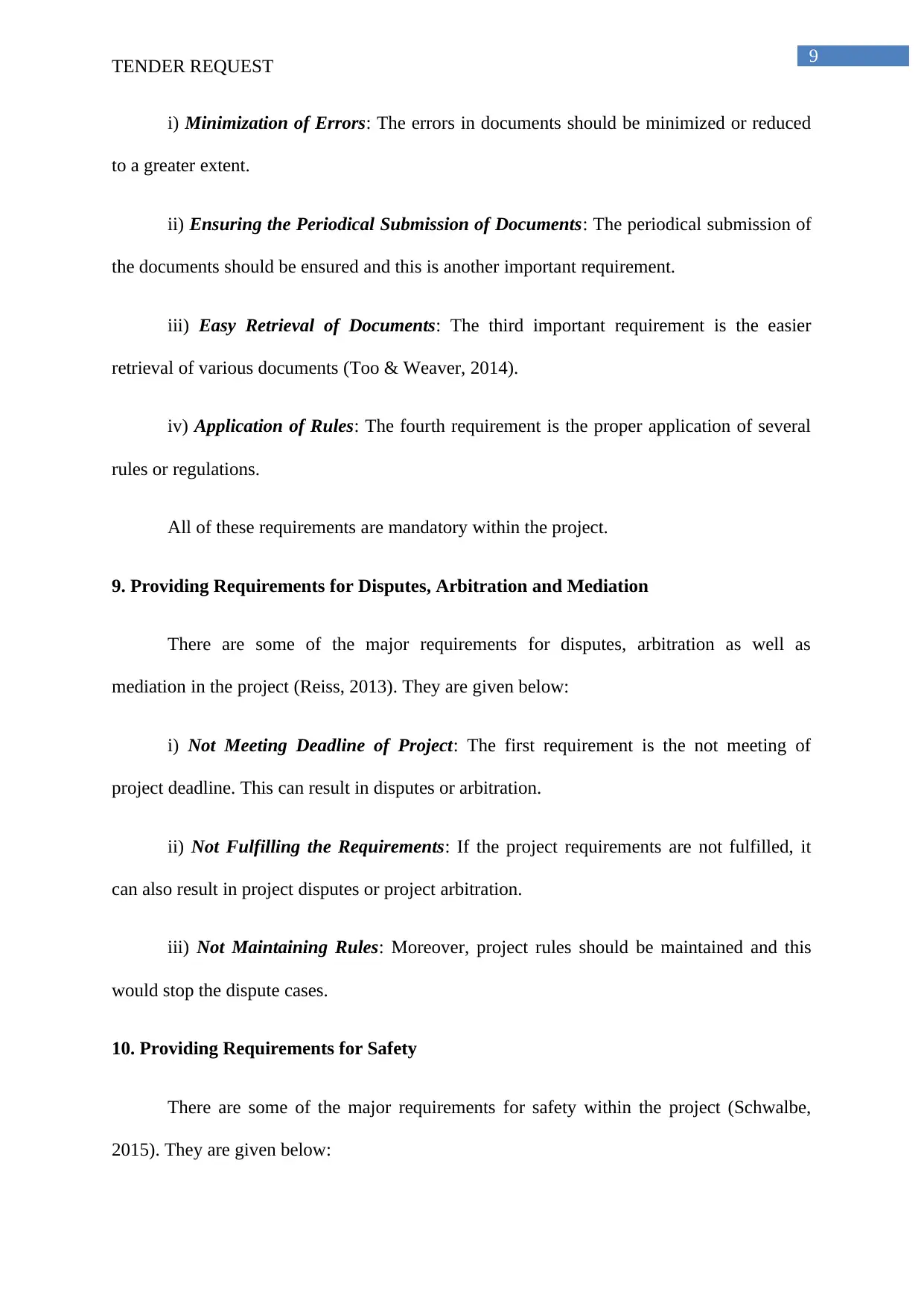
9
TENDER REQUEST
i) Minimization of Errors: The errors in documents should be minimized or reduced
to a greater extent.
ii) Ensuring the Periodical Submission of Documents: The periodical submission of
the documents should be ensured and this is another important requirement.
iii) Easy Retrieval of Documents: The third important requirement is the easier
retrieval of various documents (Too & Weaver, 2014).
iv) Application of Rules: The fourth requirement is the proper application of several
rules or regulations.
All of these requirements are mandatory within the project.
9. Providing Requirements for Disputes, Arbitration and Mediation
There are some of the major requirements for disputes, arbitration as well as
mediation in the project (Reiss, 2013). They are given below:
i) Not Meeting Deadline of Project: The first requirement is the not meeting of
project deadline. This can result in disputes or arbitration.
ii) Not Fulfilling the Requirements: If the project requirements are not fulfilled, it
can also result in project disputes or project arbitration.
iii) Not Maintaining Rules: Moreover, project rules should be maintained and this
would stop the dispute cases.
10. Providing Requirements for Safety
There are some of the major requirements for safety within the project (Schwalbe,
2015). They are given below:
TENDER REQUEST
i) Minimization of Errors: The errors in documents should be minimized or reduced
to a greater extent.
ii) Ensuring the Periodical Submission of Documents: The periodical submission of
the documents should be ensured and this is another important requirement.
iii) Easy Retrieval of Documents: The third important requirement is the easier
retrieval of various documents (Too & Weaver, 2014).
iv) Application of Rules: The fourth requirement is the proper application of several
rules or regulations.
All of these requirements are mandatory within the project.
9. Providing Requirements for Disputes, Arbitration and Mediation
There are some of the major requirements for disputes, arbitration as well as
mediation in the project (Reiss, 2013). They are given below:
i) Not Meeting Deadline of Project: The first requirement is the not meeting of
project deadline. This can result in disputes or arbitration.
ii) Not Fulfilling the Requirements: If the project requirements are not fulfilled, it
can also result in project disputes or project arbitration.
iii) Not Maintaining Rules: Moreover, project rules should be maintained and this
would stop the dispute cases.
10. Providing Requirements for Safety
There are some of the major requirements for safety within the project (Schwalbe,
2015). They are given below:
Paraphrase This Document
Need a fresh take? Get an instant paraphrase of this document with our AI Paraphraser
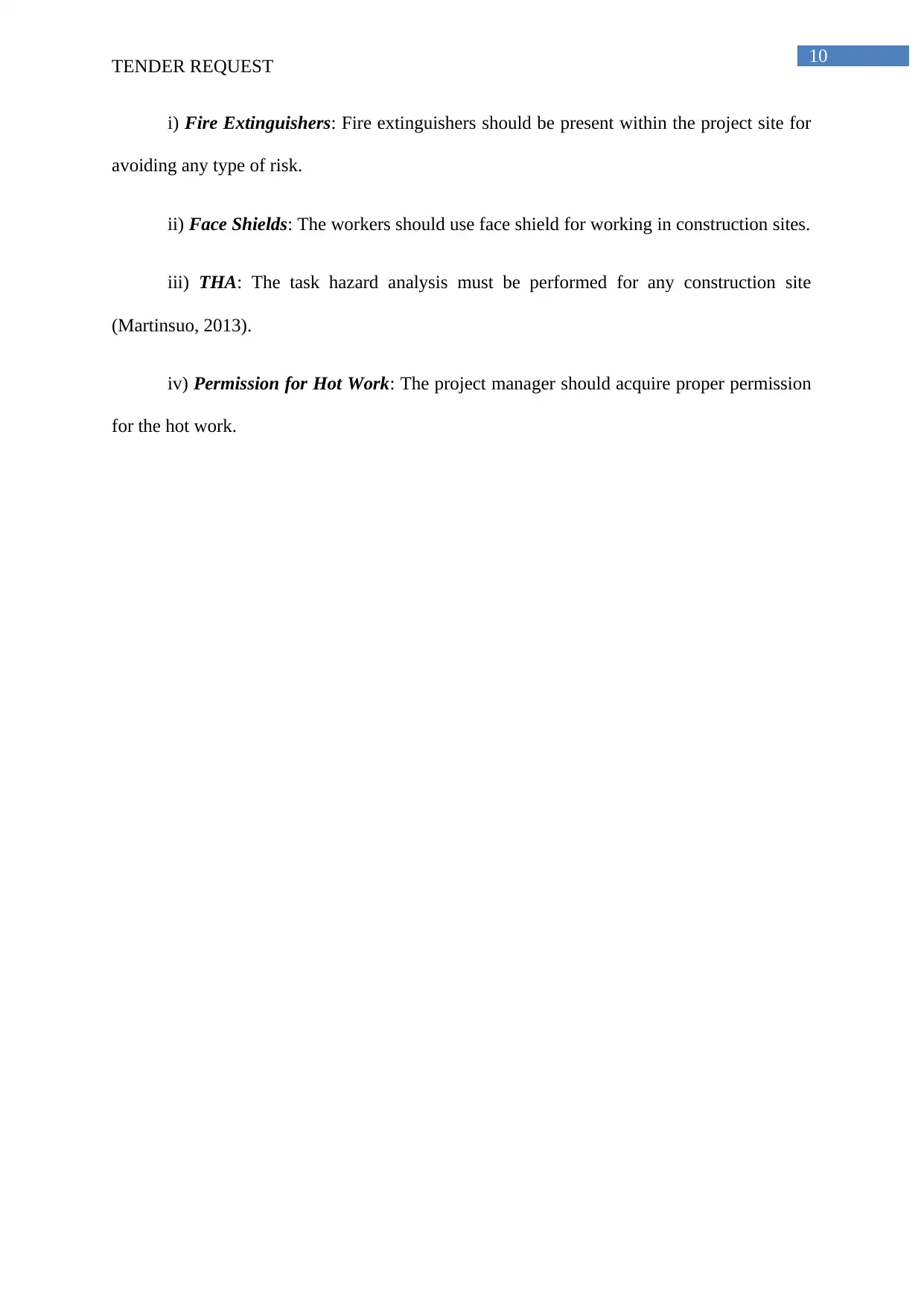
10
TENDER REQUEST
i) Fire Extinguishers: Fire extinguishers should be present within the project site for
avoiding any type of risk.
ii) Face Shields: The workers should use face shield for working in construction sites.
iii) THA: The task hazard analysis must be performed for any construction site
(Martinsuo, 2013).
iv) Permission for Hot Work: The project manager should acquire proper permission
for the hot work.
TENDER REQUEST
i) Fire Extinguishers: Fire extinguishers should be present within the project site for
avoiding any type of risk.
ii) Face Shields: The workers should use face shield for working in construction sites.
iii) THA: The task hazard analysis must be performed for any construction site
(Martinsuo, 2013).
iv) Permission for Hot Work: The project manager should acquire proper permission
for the hot work.
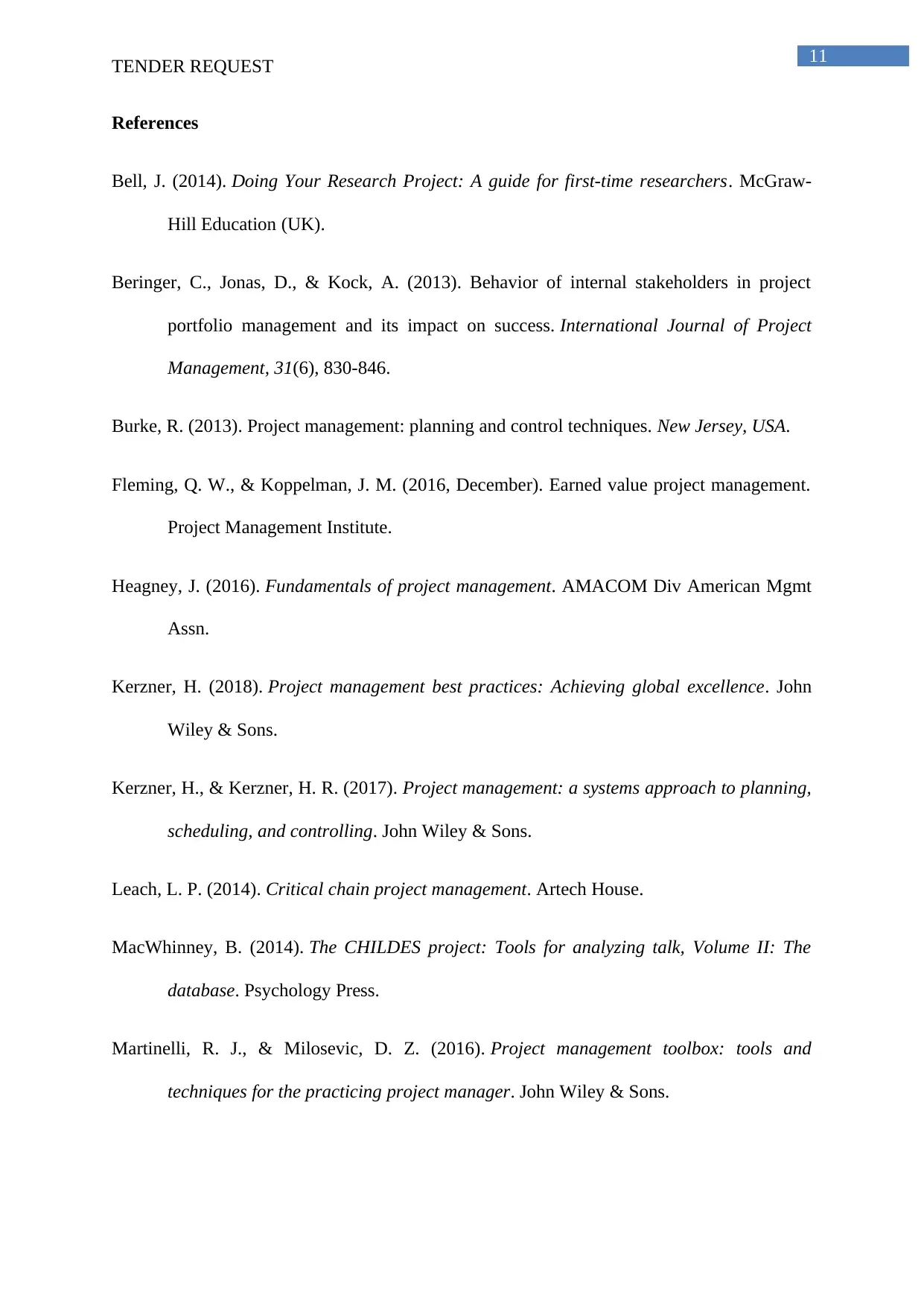
11
TENDER REQUEST
References
Bell, J. (2014). Doing Your Research Project: A guide for first-time researchers. McGraw-
Hill Education (UK).
Beringer, C., Jonas, D., & Kock, A. (2013). Behavior of internal stakeholders in project
portfolio management and its impact on success. International Journal of Project
Management, 31(6), 830-846.
Burke, R. (2013). Project management: planning and control techniques. New Jersey, USA.
Fleming, Q. W., & Koppelman, J. M. (2016, December). Earned value project management.
Project Management Institute.
Heagney, J. (2016). Fundamentals of project management. AMACOM Div American Mgmt
Assn.
Kerzner, H. (2018). Project management best practices: Achieving global excellence. John
Wiley & Sons.
Kerzner, H., & Kerzner, H. R. (2017). Project management: a systems approach to planning,
scheduling, and controlling. John Wiley & Sons.
Leach, L. P. (2014). Critical chain project management. Artech House.
MacWhinney, B. (2014). The CHILDES project: Tools for analyzing talk, Volume II: The
database. Psychology Press.
Martinelli, R. J., & Milosevic, D. Z. (2016). Project management toolbox: tools and
techniques for the practicing project manager. John Wiley & Sons.
TENDER REQUEST
References
Bell, J. (2014). Doing Your Research Project: A guide for first-time researchers. McGraw-
Hill Education (UK).
Beringer, C., Jonas, D., & Kock, A. (2013). Behavior of internal stakeholders in project
portfolio management and its impact on success. International Journal of Project
Management, 31(6), 830-846.
Burke, R. (2013). Project management: planning and control techniques. New Jersey, USA.
Fleming, Q. W., & Koppelman, J. M. (2016, December). Earned value project management.
Project Management Institute.
Heagney, J. (2016). Fundamentals of project management. AMACOM Div American Mgmt
Assn.
Kerzner, H. (2018). Project management best practices: Achieving global excellence. John
Wiley & Sons.
Kerzner, H., & Kerzner, H. R. (2017). Project management: a systems approach to planning,
scheduling, and controlling. John Wiley & Sons.
Leach, L. P. (2014). Critical chain project management. Artech House.
MacWhinney, B. (2014). The CHILDES project: Tools for analyzing talk, Volume II: The
database. Psychology Press.
Martinelli, R. J., & Milosevic, D. Z. (2016). Project management toolbox: tools and
techniques for the practicing project manager. John Wiley & Sons.
⊘ This is a preview!⊘
Do you want full access?
Subscribe today to unlock all pages.

Trusted by 1+ million students worldwide
1 out of 13
Related Documents
Your All-in-One AI-Powered Toolkit for Academic Success.
+13062052269
info@desklib.com
Available 24*7 on WhatsApp / Email
![[object Object]](/_next/static/media/star-bottom.7253800d.svg)
Unlock your academic potential
Copyright © 2020–2025 A2Z Services. All Rights Reserved. Developed and managed by ZUCOL.




